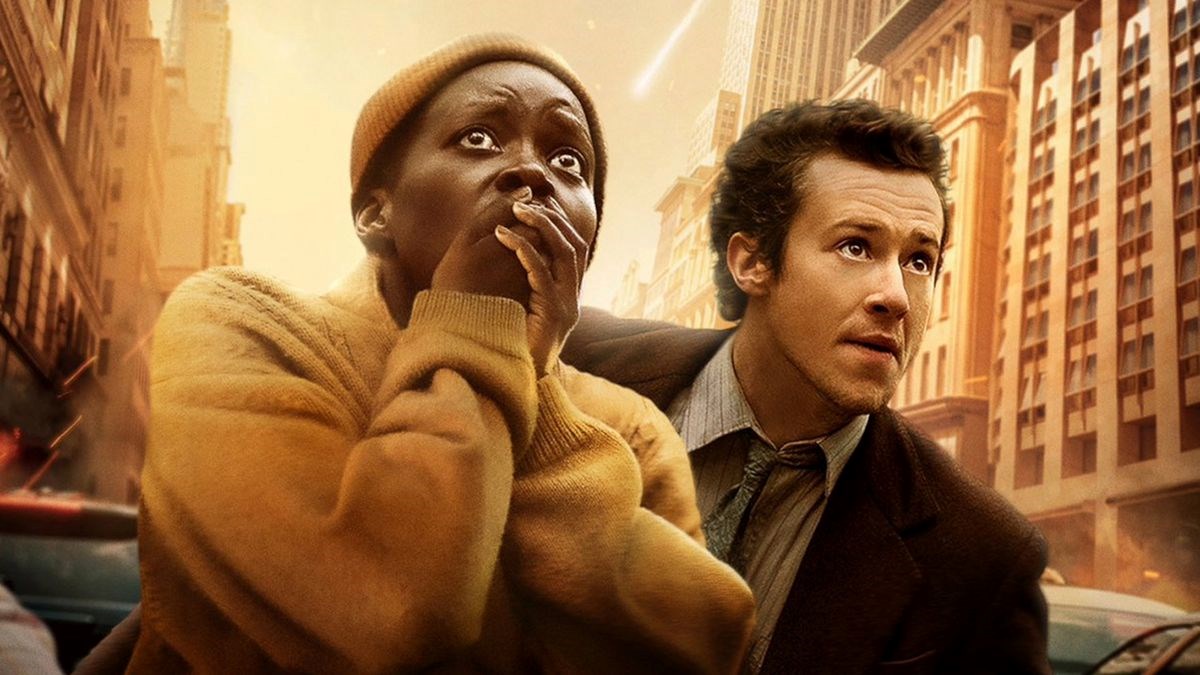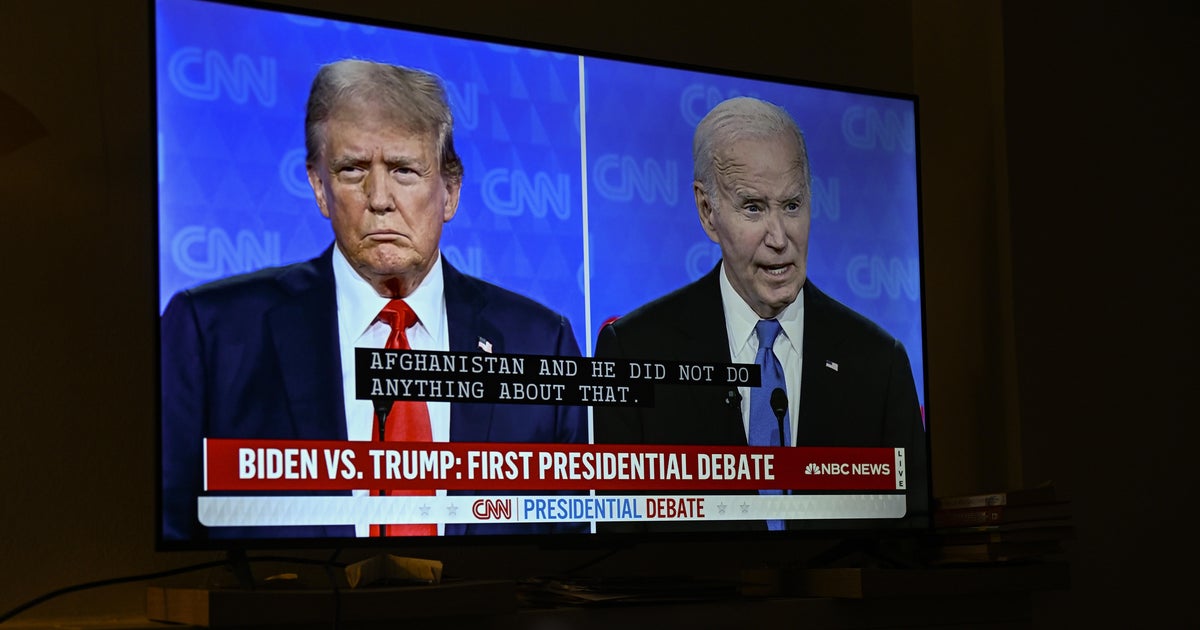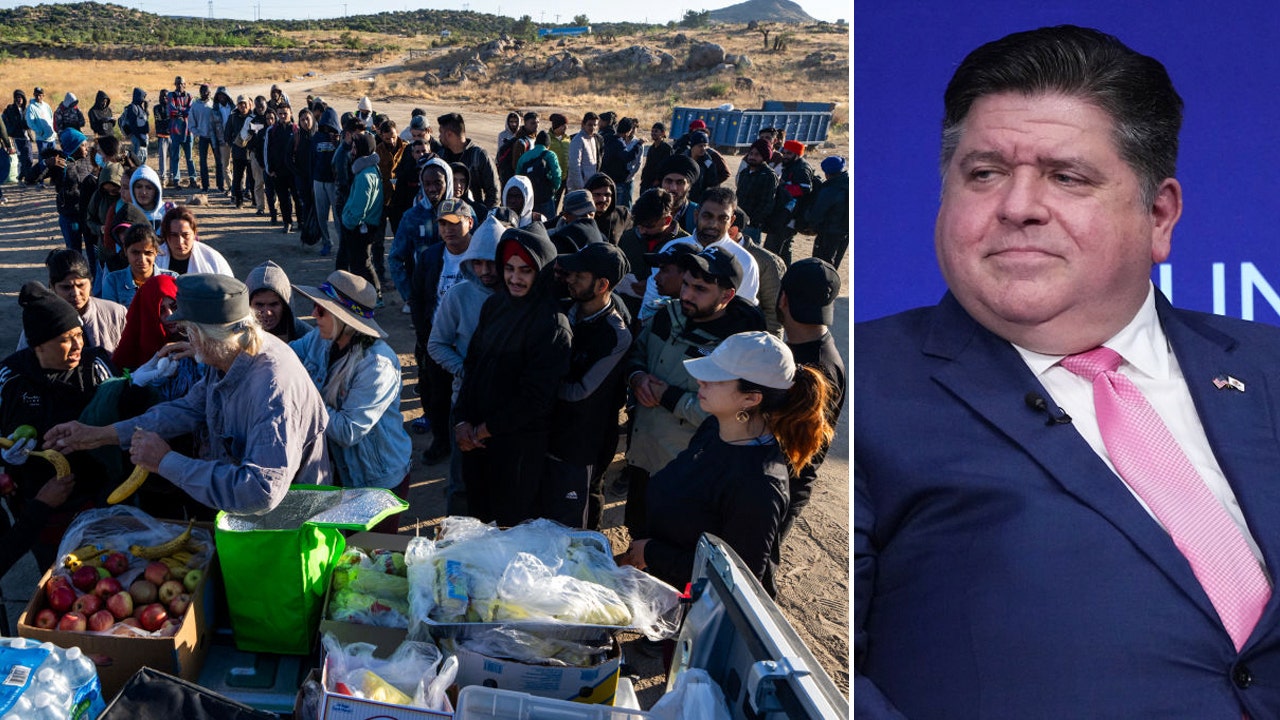New York
What We Know About the Chaos Caused by a Twitch Star’s Giveaway

A gathering of thousands of people in Manhattan’s Union Square Park on Friday quickly became an unruly scene, with dozens of police officers called to quell the chaos.
Many in the crowd were looking to get free video game consoles that would be handed out by a popular social media streamer. However, by Friday evening, the police had arrested dozens of people, including the live-streamer who organized the event, Kai Carlo Cenat III, who was charged with inciting a riot.
Here’s what we know.
What set off the mayhem?
Kai Carlo Cenat III and a fellow streamer, Fanum, recently told their millions of followers that they would give away PlayStation 5 consoles at Union Square Park on Friday at 4 p.m.
The police said the streamers had not acquired a permit to hold the huge gathering.
Throngs of young people had formed at the park by 3 p.m., according to the police. But the crowd soon grew “exponentially” and began to spill onto the nearby streets, blocking pedestrians and cars.
Most of those in the crowd were peaceful, but some people were unruly, especially as the scheduled giveaway time passed, the police said.
What did the crowd do?
Around 4 p.m., some people in the crowd began to hurl objects including building materials, rocks and bottles at one another, the police said. Fireworks also popped in the crowd.
One cluster of people stormed a construction site. Another group pushed back against police officers carrying riot shields as they tried to move in to make arrests.
Images from the scene showed people climbing onto cars stuck in the crowd, stopping traffic and banging on vehicles while others threw objects.
At 20th Street, some in the crowd sat on wicker chairs belonging to a restaurant; at 22nd Street, dozens of young people stormed through a CVS to grab water and food for others.
As the police pressed the crowd up Park Avenue, some people vandalized cars, storefronts and food carts, officials said.
The chaotic gathering ended around 6 p.m.
Mayor Eric Adams said on Saturday that it was possible that “outside agitators” had attempted “to aggravate the situation.”
How many were arrested?
The police said that officers had arrested 65 people, nearly half of whom were juveniles.
Who is Kai Cenat?
Mr. Cenat, 21, is a popular YouTube creator and Twitch streamer from New York City who is known for his high-energy videos and boisterous personality. He is among the most-watched streamers on Twitch, and his fan base is mostly young people. Mr. Cenat’s videos include reactions to songs and trailers, parodies, internet challenges and video game streams.
Rolling Stone named him one of the 20 most influential creators of 2023.
On Friday, Mr. Cenat posted a video about the unruliness at Union Square Park. In the video, which is titled “Kai Cenat Shuts Down New York City,” Mr. Cenat is in a vehicle, secluded from the apparent uproar outside.
“It’s a lot of y’all out there right now,” he says in the eight-minute video. It is unclear what time he filmed it. “Everybody who is out there, make sure y’all are safe.”
What charges does Kai Cenat face?
Mr. Cenat was charged with first-degree rioting, a felony, as well as inciting a riot and unlawful assembly, which are misdemeanors, according to a city spokesman. Mr. Cenat was released from police custody soon after and given a court appearance date.
Hurubie Meko contributed reporting.

New York
5,000 Miles, 8 Countries: The Path to the U.S. Through One Family’s Eyes

The three children had not bathed in four days.
They had been sleeping in a makeshift tent on a dirty street outside a bus terminal in Mexico City, and Hayli, only 6, was developing a rash between her legs. But the parents could not spare the 20 pesos, or roughly $1, for a bucket shower.
After a 55-day trek through Latin America, the five members of the Aguilar Ortega family were stranded more than 3,000 miles from their Venezuelan homeland, and almost as many miles from their intended destination: New York City.
It had been a week since they had arrived in Mexico City, and they had no money to proceed north. The children — Hayli, Samuel, 10, and Josué, 11 — were in good spirits, imagining aloud what it would be like to live in New York. But for the parents, Henry Aguilar, 34, and his partner, Leivy Ortega, 29, the lull demanded a reassessment of what still lay ahead.
While Mayor Eric Adams of New York spoke at a nearby conference in Mexico City, the Aguilar Ortega family slept in tents.
Millions of Venezuelans like the Aguilar Ortega family have fled economic misery and political repression in their homeland as it descended into turmoil. The exodus has led to a sharp increase in crossings at the U.S. border, reigniting immigration as one of the most polarizing issues ahead of the presidential election.
Indeed, the Biden administration recently took executive action to limit the number of migrants crossing the southern border. The decision angered critics who contend that it contradicts America’s image as a safe harbor for the vulnerable. But others welcomed the move amid concerns that migrants were being let in with few checks.
Mr. Aguilar embodied that paradox. He set off for the United States with a turbulent past as a soldier, police officer and bodyguard in Venezuela, and after a prison stint that could derail his chances of securing asylum.
But Mr. Aguilar was hoping to start anew.
Ms. Ortega dreamed of maybe one day opening a restaurant. Both were chasing a vague promise of a better future in the United States while casting aside the real possibility that his criminal history could render the family’s hardship for naught.
The New York Times documented the family’s one-year odyssey, first meeting them in Mexico City, and then rejoining them at the U.S.-Mexican border. The ordeal would test their mental and physical fortitude, strain the parents’ relationship, and challenge their commitment and ability to build a new life in the United States.
The family’s dog, Donna, was with the family every step of the journey.
The journey took them through a jungle of dead bodies and was filled with dangers that terrified the parents, including an obstacle course of dirty police officers, smugglers and immigration checkpoints they traversed on foot and by bus. They had to panhandle, sell lollipops and hustle up odd jobs along the way.
But for the children, the journey was framed as a daring family experience. They took pictures and recorded video that they shared with The Times. They even brought their coffee-colored Labrador mix, Donna. In their eyes, it was all part of a big adventure that would end in a place they had seen only in movies.
“The kids want to go to New York,” Mr. Aguilar said in Spanish as he stood by his tent in Mexico City. “They want to see Times Square.”
But his American dream was even simpler: “All I want is to take my kids to play ball in a park,” he said.
MAY – AUGUST 2023 COLOMBIA
Samuel, Hayli and Josué pose for a photo in Colombia, where along the way they slept in a town plaza for two weeks.
The Decision to Go to New York
Mr. Aguilar left Venezuela about six years ago, part of a flight of more than seven million people who have escaped a once-wealthy country where the economy collapsed and crime skyrocketed under President Nicolás Maduro.
Three years later, Mr. Aguilar found himself in Chile, where he sparked a romance with Ms. Ortega, who is also Venezuelan, and they blended their families. Ms. Ortega left behind a 13-year-old daughter in Ecuador because she was too sick to travel.
Besides Ecuador, the family also spent time in Peru before setting their sights on the United States at the children’s prodding. So they headed to Colombia but with no money, no plan and no place to sleep — a frequent plight during their voyage.
They slept in a town plaza there for two weeks before Mr. Aguilar and Ms. Ortega gathered enough money to rent a home. Colombia, Mr. Aguilar thought, was where he would prepare the children for the menacing rainforest between Colombia and Panama known as the Darién Gap.
“It’s going to be a grand adventure,” Mr. Aguilar recalled telling them. “But with real-life obstacles.”
So Mr. Aguilar put them through an at-home boot camp with a summer camp feel, letting them ride bicycles to boost their stamina.
He woke them up before 7 a.m., but their breakfast portions were small to brace for the coming hunger.
Crossing the Darién Gap
At first, the journey into “la selva,” or the jungle, had the trappings of an organized tour.
The family was given pink wristbands after paying $300 to the armed men who control access to the Darién Gap. And surrounded by hundreds of Venezuelans, they even had a sense of anticipation as they smiled for selfies, their clothes still clean.
That excitement would fade as they waded into the jungle’s depths.
Their feet were rubbed raw as they trudged through mud. Hayli lost two toenails and cried as dirt seeped into the exposed skin. Torrents of rain made rivers roar, forcing Mr. Aguilar to ferry each family member across, one by one — with Donna the Labrador’s stubbornness nearly drowning him.

“Muerto! Muerto!” those toward the front would call back as they passed the bodies of migrants. “Dead! Dead!”
Ms. Ortega generously, but perhaps naïvely, shared the family’s food with other migrants, leaving the family to subsist on nothing but river water on the last two days of the six-day hike through the jungle.
It was hard to hide the brutality of the journey from the children.
“No puedo,” Ms. Ortega would say. “I can’t.”
AUGUST – OCTOBER PANAMA TO MEXICO CITY
The parents presented the journey as a grand adventure to the children.

The family used currency to keep track of places they went through in Guatemala and Mexico.
Getting to Mexico City
Once out of the jungle, the children were committed to the adventure as they crisscrossed dirt roads and slipped from one country into the next.
Josué, ever talkative, told anyone within earshot that they were headed to New York to see Times Square, or las pantallas: the screens.
Samuel, the most reserved of the three, assumed the role of navigator. He quietly tracked their trek on a wrinkled map of Central America as Donna meandered without a leash.
Hayli was always the first to smile for pictures, flashing her tooth gap. Her small legs carried her for hours, as the family circumvented border checkpoints in Panama, Costa Rica, Nicaragua, Honduras and Guatemala.
But for the parents, the burden of not having money was inescapable.
There was transportation to arrange and immigration officers to grease. Bus companies would charge them double or refuse to sell them tickets because they were migrants, a taste of the prejudice that awaited them further north.
They often slept in tents on the street, and going to sleep without eating became normal.

In Guatemala, police officers patted down migrants to steal their money. They groped Ms. Ortega’s breast, leaving her feeling violated, she said. Mr. Aguilar created hiding places for their cash, using toenail clippers to cut small openings into Hayli’s jacket and Josué’s pants. The ruse worked.
They mostly came to rely on the charity of strangers and sporadic money transfers from friends and relatives: more than $8,000 in total, the parents acknowledged with a trace of shame.
OCTOBER – NOVEMBER MEXICO CITY TO CIUDAD JUÁREZ, Mexico

Hopping Freight Trains
The family rode a succession of freight trains to the U.S. border.
The wait for a train could last for hours, especially in the dead of night. When one stopped, they would all emerge from hiding near the tracks and clamber onto a car’s metal roof.
They fastened themselves as best they could, wrapped loosely in rope and blankets, the wind blowing against their faces as they left behind Mexico City.

They were riding “la bestia,” or the beast, the frightening nickname for the cargo trains that many migrants hop illegally, hoping to evade checkpoints and cartels. Countless people have died or lost limbs riding the trains.
Ms. Ortega wrapped her legs around Hayli and prayed that the boys would not fall off. Bundled in quilts, the boys squinted their eyes against the cold breeze, taking in the arid shrub land.
The nights were the hardest. They battled falling asleep, fearful with each jerk of the train that they would fall off.
NOV. 9-10 CIUDAD JUÁREZ, MEXICO
A family selfie along the border in Ciudad Juárez, Mexico, before they crossed into Texas.
Ms. Ortega looks at a family ring, the only heirloom she brought from Venezuela.
On their last night in Juárez, the family left for the border patrol checkpoint at 3 a.m.
Approaching the Border
The Times reconnected with the family in Ciudad Juárez, a Mexican border city where migrants are regularly smuggled and kidnapped for ransom, and sometimes murdered. The Aguilar Ortegas were visibly disheveled, emerging from the last train with little but the clothes on their back, closer than ever to the United States.
“Time is going by slowly now,” Mr. Aguilar said after taking the children to glance at the Rio Grande. Texas was just a few yards away, behind a towering fence.
Using a mobile app that the Biden administration has relied on to curb illegal crossings, the family had secured a coveted appointment to enter the United States legally the next day — the first step for many migrants seeking asylum.
But with no money left for food that night, they decided to pawn Ms. Ortega’s white gold ring, her last family heirloom.
A pawnshop offered her 400 pesos, or $23 — a lowball price, she thought, perhaps because she was Venezuelan. She found a Mexican man to sell the ring for her.
The shop offered him more than double, about $70. She took the money, feeling sad but clever, and slightly empowered.
Entering the United States
As dawn crept across the Rio Grande, migrants from Cuba, Haiti and Venezuela with immigration appointments braced the frigid desert air on a bridge connecting Ciudad Juárez to El Paso, Texas.
After entering so many countries illegally, the family’s final border crossing was to be entirely lawful. But that did little to ease their nerves as federal officers began to check their passports, take fingerprints and photographs, and swab their cheeks for DNA.
It is not clear what immigration officials knew of Mr. Aguilar.
He had a tumultuous upbringing in Venezuela: He said he was kicked out of the house as a teenager, and was in a motorcycle accident that resulted in permanent memory loss that blurs his childhood.
Still, he recalled dreaming of becoming a detective, and after a stop in the military, he joined Venezuela’s largest national police agency, which is heavily politicized and has a history of corruption.
Mr. Aguilar was part of a SWAT-like unit that specialized in taking down organized crime when, as a 21-year-old police officer, he was arrested and charged in 2010 with abusing his authority.
Venezuelan prosecutors accused him of participating in an armed shakedown of someone who owed his friend money. The friend and Mr. Aguilar, said to be carrying another officer’s gun, were accused of holding several people at gunpoint and stealing money and bottles of whiskey. Mr. Aguilar was charged with aggravated robbery, extortion and embezzlement, according to the few court documents available online.
Mr. Aguilar says Venezuelan prosecutors distorted the charges and that he and his friend weren’t violent. In court documents, he portrayed himself as accompanying his friend for backup. He eventually served two years in prison, he said.
At the U.S. border, background checks did not appear to turn up Mr. Aguilar’s criminal past. The family was released on parole — a status that allows migrants without visas to live and work in the country as their asylum cases wind through the courts.
Mr. Aguilar’s first court appearance before an immigration judge is scheduled for April 2025. He doesn’t know how he intends to deal with his past: The government can bar asylum for people convicted of serious crimes, and Mr. Aguilar would have to disclose his record on his asylum application.
None of that was front of mind as the family walked into downtown El Paso, ushered in by an archway with a familiar greeting: Bienvenidos.
NOV. 10-24 EL PASO, TEXAS
The family shared tight quarters in a shelter with other migrants arriving daily to El Paso.
Mr. Aguilar slept outside the shelter in El Paso with Donna, because dogs weren’t allowed.
Tumult in Texas
By Day 3 in El Paso, the family was already in turmoil. Ms. Ortega had gotten in a fight at a shelter with three Venezuelan women after tempers flared in the dinner line. The family was forced to go to another shelter.
Ms. Ortega sat down on a stoop, her face scratched, and began to cry.
They were told they did not qualify for free migrant buses out of Texas. And while they had collected $120 — mostly thanks to Donna, who attracted generous passers-by — commercial bus transport to New York was up to $450 per person. They had survived a treacherous monthslong journey, only to be stranded again.
Ms. Ortega thought of the upcoming birthday of her daughter in Ecuador, and wondered if she would have money for a gift. She spoke wistfully about a friend who had made it to New York and already had an apartment and enough money to help his family in Venezuela.
“It’s not envy, but I want to be over there already,” she said through tears. “I feel stuck here. It hasn’t even been 72 hours and I’ve already been hit.”
Mr. Aguilar consoled her. “It’s always been like this,” he said. “But we always figure it out.”
The journey had taken its toll on the children. When Josué and Samuel played with toy cars on the sidewalk, they re-enacted scenes from their young lives: immigration police officers chasing migrants.
And tensions between the parents began to simmer as they deciphered what to do next. Was New York even the right place to go?
“Things are tough in New York with the 100,000 migrants who have arrived there,” Father Rafael García warned them gently at their first shelter, which is run by the Roman Catholic Church.
Taped to the shelter wall, a flier in Spanish paid for by New York City offered a more dire assessment: “It’s best if you go to a more affordable city.”
The flight the family took to New York was the first time Ms. Ortega had been on a plane.

After arriving, the family headed for a familiar migrant starting point, the Roosevelt Hotel.
Fasten Your Seatbelts
Hayli cried when her ears popped for the first time as the plane gained altitude, but once it glided into La Guardia Airport, her sense of wonder took over.
“Papi, the bathroom was magical!” she exclaimed, recounting how the hand dryers and toilets sprung to life via sensors.
Just a few weeks earlier, New York had seemed out of reach. But in El Paso, the family met a group of Christian missionaries from Michigan who, taken aback by their story, raised nearly $2,000 for Delta flights.
And so it was that the family landed in New York the day after Thanksgiving with 20 cents, their few belongings stuffed inside a donated suitcase and a pink sleeping bag that Mr. Aguilar hauled like Santa Claus.
The family had heard that if they went to a place called Manhattan, they could get free shelter at the Roosevelt Hotel, the welcoming center for the 200,000 migrants who have recently come to the city.
At a Queens subway station, they persuaded a Spanish-speaking police officer to let them in without paying the fare. They climbed a maze of stairs and almost boarded the wrong train until a passer-by offered them guidance.
The children stared out the 7 train in awe as the city skyline materialized against an orange sunset.
“Better than riding the top of a train,” Mr. Aguilar said.
NOV. 25 – DEC. 9 MANHATTAN AND BROOKLYN
For the children, Times Square was the goal. They stared in awe at the lit-up screens and the costumed superheroes.

The family celebrated Ms. Ortega’s 29th birthday at the Floyd Bennett Field shelter in Brooklyn.
Trying to Make It in New York
The children held hands in Times Square. They strolled around Central Park, posing for a picture by the statue of Simón Bolivar, the revered Venezuelan who fought Spain.
But the allure of sightseeing quickly gave way to challenges: finding jobs, permanent housing, a sense of stability.
They had been assigned to a far-flung Brooklyn shelter at Floyd Bennett Field, an old airfield on Jamaica Bay where the city is housing hundreds of families in a giant tent dormitory.
Upset by the tent environment and its distance from Manhattan, Mr. Aguilar, prone to making rash decisions, initially rejected the shelter’s free room and board before acknowledging it was the family’s only option.
“I was being rebellious,” Mr. Aguilar said. “I’ve been wrong so many times before. I’m not perfect.”
But the parents began getting antsy. The shelter was getting crowded. They didn’t speak English or know how to apply for a legal work permit.
So after just three weeks, Mr. Aguilar uprooted his family again.
DECEMBER – MARCH MIDDLETOWN, CONN.
The family was placed into a two-bedroom home in Middletown, Conn., after leaving the shelter system in New York.
Hayli and the boys were enrolled in schools, where they quickly picked up English.
A New Home in Connecticut
A few days before Christmas, the family was sleeping in a car outside a gas station in Brooklyn.
The children snuggled tightly in the back seat, braving the cold in a beat-up Honda sedan Mr. Aguilar had found on Facebook for $800. Then good fortune intervened.
During a brief stay in Connecticut a few weeks earlier, the family had met Maria Cardona, who works at a social services provider there. She called Ms. Ortega to check in, and learned of the family’s setup. She immediately made some calls.
“Their situation impacted me deeply,” Ms. Cardona said.
She helped them move into a two-bedroom house on a leafy street in Middletown, Conn., operated by a local nonprofit that provides free emergency housing for homeless families. The family was allowed to stay on a month-by-month basis if they showed a case manager they were actively looking for employment and a permanent home.
More help arrived.

Amy Swan, the psychologist at the children’s elementary school, gathered donations of food and clothes, as well as money to pay the $410 fee for Mr. Aguilar to apply for a permit to work legally.
Her husband, Ray Swan, owns a wood workshop and was looking for a worker. So he hired Mr. Aguilar, who worked in carpentry after leaving Venezuela, and began paying him $20 an hour to build furniture and kitchen cabinets.
“He works hard and doesn’t complain,” Mr. Swan said at his workshop in March. “I can’t stop singing his praises.”
MARCH – JULY MIDDLETOWN, CONN. TO HOUSTON
After abruptly leaving Connecticut for Houston, the family faced new challenges.

The parents share news of her pregnancy with their three children.
More Turmoil and an Uncertain Future
In early March, the family received more welcome news: Ms. Ortega was pregnant.
She’s expected to give birth later this year. Having a child who is a U.S. citizen would not give the parents any special protections against deportation, leaving the family’s immigration status in flux.
Immigration lawyers said that Mr. Aguilar’s past will seriously complicate his bid for asylum, an uphill process that usually ends with judges saying no.
“If it’s God’s will that I’m not here in two years, then so be it,” Mr. Aguilar said in Connecticut in March. “I’m happy being with my family and making them happy.”
But the parents were still stressing about their future, and their relationship continued to fray. One night in mid-April, Ms. Ortega grabbed a baseball bat and swung at Mr. Aguilar, hitting his hands. She said it happened in the heat of the moment. Mr. Aguilar was not injured and did not hit back.
She was arrested on a misdemeanor charge of disorderly conduct, and a protective order was issued to keep Ms. Ortega away from Mr. Aguilar. He lost his carpentry job, and the family was forced from the house. Mr. Aguilar was placed in a shelter for domestic violence victims with his children, Samuel and Hayli; Ms. Ortega was set up elsewhere with Josué, her son.
The family was languishing again — apart, with a baby on the way and their immigration status still in question.
Desperate, they fell back on the same spur-of-the-moment manner that guided their travels. Ignoring the protective order and strapped for money, the parents reconciled and abandoned Connecticut, leaving Ms. Ortega’s court case unresolved. They hauled the children and Donna south in the old Honda, hoping it wouldn’t break down.
About 1,700 miles and five days later, they arrived in Houston, where the mother of Mr. Aguilar’s two children took the family in, cramming into a small apartment with mattresses on the floor.
Mr. Aguilar is applying for landscaping jobs while doing delivery gigs. Ms. Ortega has been satisfying her pregnancy cravings with mangos.
But, ever restless, the parents were already hatching next moves.
Denver seemed promising. Salt Lake City, perhaps.
In Houston, at least, Mr. Aguilar had fulfilled his wish: He found a park to play catch with the children.
New York
We Counted 22,252 Cars to See How Much Congestion Pricing Might Have Made This Morning

Today would have been the first Monday of New York City’s congestion pricing plan. Before it was halted by Gov. Kathy Hochul, the plan was designed to rein in some of the nation’s worst traffic while raising a billion dollars for the subway every year, one toll at a time.
A year’s worth of tolls is hard to picture. But what about a day’s worth? What about an hour’s?
To understand how the plan could have worked, we went to the edges of the tolling zone during the first rush hour that the fees would have kicked in.
Here’s what we saw:
Video by Noah Throop/The New York Times; animation by Ruru Kuo/The New York Times
You probably wouldn’t have seen every one of those cars if the program had been allowed to proceed. That’s because officials said the fees would have discouraged some drivers from crossing into the tolled zone, leading to an estimated 17 percent reduction in traffic. (It’s also Monday on a holiday week.)
The above video was just at one crossing point, on Lexington Avenue. We sent 27 people to count vehicles manually at four bridges, four tunnels and nine streets where cars entered the business district. In total, we counted 22,252 cars, trucks, motorcycles and buses between 8 a.m. and 9 a.m. on Monday.
We wanted to see how the dense flow of traffic into the central business district would have generated money in real time.
Though we can’t know that dollar amount precisely, we can hazard a guess. Congestion pricing was commonly referred to as a $15-per-car toll, but it wasn’t so simple. There were going to be smaller fees for taxi trips, credits for the tunnels, heftier charges for trucks and buses, and a number of exemptions.
To try to account for all that fee variance, we used estimates from the firm Replica, which models traffic data, on who enters the business district, as well as records from the Metropolitan Transportation Authority and city agencies. We also made a few assumptions where data wasn’t available. We then came up with a ballpark figure for how much the city might have generated in an hour at those toll points.
The total? About $200,000 in tolls for that hour.
Note: The Trinity Place exit from the Brooklyn-Battery Tunnel, which would have been tolled, is closed at this hour.
It’s far from a perfect guess. Our vehicle total is definitely an undercount: We counted only the major entrances — bridges, tunnels and 60th Street — which means we missed all the cars that entered the zone by exiting the Franklin D. Roosevelt Drive or the West Side Highway.
And our translation into a dollar number is rough. Among many other choices we had to make, we assumed all drivers had E-ZPass — saving them a big surcharge — and we couldn’t distinguish between transit buses and charter buses, so we gave all buses an exemption.
But it does give you a rough sense of scale: It’s a lot of cars, and a lot of money. Over the course of a typical day, hundreds of thousands of vehicles stream into the Manhattan central business district through various crossings.
Trips into tolling district, per Replica estimates Note: Data counts estimated entrances on a weekday in spring 2023. Source: Replica.
Queens-Midtown Tunnel
50,600
Lincoln Tunnel
49,200
Williamsburg Bridge
27,900
Manhattan Bridge
24,000
Brooklyn-Battery Tunnel
23,100
Queensboro Bridge
21,700
Brooklyn Bridge
17,100
Holland Tunnel
15,400
All other entrances
118,000
Total
347,000
The tolling infrastructure that was installed for the program cost roughly half a billion dollars.
The M.T.A. had planned to use the congestion pricing revenue estimates to secure $15 billion in financing for subway upgrades. Many of those improvement plans have now been suspended.
Methodology We stationed as many as five counters at some bridges and tunnels to ensure that we counted only cars that directly entered the tolling zone, not those that would have continued onto non-tolled routes.
Our count also excluded certain exempt vehicles like emergency vehicles.
We used estimates of the traffic into the district to make a best guess at how many of each kind of vehicle entered the zone. Most of our estimates came from the traffic data firm Replica, which uses a variety of data sources, including phone location, credit card and census data, to model transportation patterns. Replica estimated that around 58 percent of trips into the central business district on a weekday in spring 2023 were made by private vehicles, 35 percent by taxis or other for-hire vehicles (Uber and Lyft) and the remainder by commercial vehicles.
We also used data on trucks, buses, for-hire vehicles and motorcycles from the M.T.A., the Taxi and Limousine Commission and the Department of Transportation.
For simplicity, we assumed all vehicles would be equally likely to enter the zone from 8 a.m. to 9 a.m. as they would be in any other hour. We could not account for the other trips that a for-hire vehicle might make once within the tolled zone, only the initial crossing. And we did not include the discount to drivers who make under $50,000, because it would kick in only after 10 trips in a calendar month.
New York
Transcript of Trump Manhattan Trial, May 30, 2024

-
Jury Deliberation Re-charge
SUPREME COURT OF THE STATE OF NEW YORK
COUNTY OF NEW YORK CRIMINAL TERM
-
-
PART: 59
Χ
THE PEOPLE OF THE STATE OF NEW YORK,
-against-
DONALD J. TRUMP,
DEFENDANT.
BEFORE:
Indict. No.
71543-2023
CHARGE
4909
FALSIFYING BUSINESS
RECORDS 1ST DEGREE
JURY TRIAL
100 Centre Street
New York, New York 10013
May 30, 2024
HONORABLE JUAN M. MERCHAN
JUSTICE OF THE SUPREME COURT
APPEARANCES:
FOR THE PEOPLE:
ALVIN BRAGG, JR., ESQ.
DISTRICT ATTORNEY, NEW YORK COUNTY
One Hogan Place
New York, New York 10013
BY:
JOSHUA STEINGLASS, ESQ.
MATTHEW COLANGELO,
ESQ.
SUSAN HOFFINGER, ESQ.
CHRISTOPHER CONROY, ESQ.
BECKY MANGOLD, ESQ.
KATHERINE ELLIS, ESQ.
Assistant District Attorneys
BLANCHE LAW
BY:
TODD BLANCHE, ESQ.
EMIL BOVE, ESQ.
KENDRA WHARTON, ESQ.
NECHELES LAW, LLP
BY: SUSAN NECHELES, ESQ.
GEDALIA STERN, ESQ.
Attorneys for the Defendant
SUSAN PEARCE-BATES, RPR, CSR, RSA
Principal Court Reporter
LAURIE EISENBERG, RPR, CSR
LISA KRAMSKY
THERESA MAGNICCARI
Senior Court Reporters
Susan Pearce-Bates, RPR, CCR, RSA
Principal Court Reporter
-

 News1 week ago
News1 week ago4 killed, 9 injured after vehicle crashes into Long Island nail salon
-

 News1 week ago
News1 week agoVideo: How Blast Waves Can Injure the Brain
-

 Movie Reviews1 week ago
Movie Reviews1 week agoMovie review: A Quiet Place, quivering since Day One
-

 Politics1 week ago
Politics1 week agoTrump says 'biggest problem' not Biden's age, 'decline,' but his policies in first appearance since debate
-

 News1 week ago
News1 week agoIncreasing numbers of voters don’t think Biden should be running after debate with Trump — CBS News poll
-

 World1 week ago
World1 week agoThe Take: The art of the debate – What the Biden-Trump face-off was missing
-

 Movie Reviews1 week ago
Movie Reviews1 week agoFilm Review: Ben and Suzanne: A Reunion in Four Parts
-

 World1 week ago
World1 week agoCaribbean braces for ‘very dangerous’ Hurricane Beryl
















